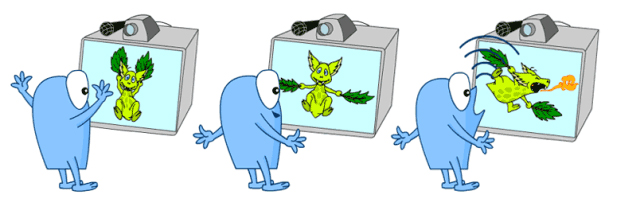|
QuiQui's Giant Bounce is an award winning computer game for 4 to 9 year old children that is controlled through movement and voice. The game does away with keyboards and traditional game controllers and uses a web camera and a microphone to "see and hear" the player. In order to play, you only need (in addition to a computer) a microphone and a web camera costing no more than 50 €, the going price for a computer game. The demo of the game can be downloaded on these pages. The game is comprised of an intriguing, fast-moving story and the physical excercises that makes up the gameplay. The player controls the main character, QuiQui, by moving in the way described in the story. For example, upon arrival to the desert, the player needs to fly the character in the sky by waving his or her hands and flexing the body. A little scream makes QuiQui let out a fiery breath.
According to our knowledge, QuiQui's Giant Bounce is the world's first computer game that combines a quality storyline with physical interaction and research on children's motor development. The game has been designed in co-operation with schools, day-care centers and the Young Finland Association. Children have been actively involved with the game-design process through their participation in usability test, brainstorming sessions and interviews. The project will also provide material for the makers' doctoral dissertation papers. More material on the game can be found in the Bouncics Today section.
The goal of the game is to offer a physically challenging alternative
to more conventional computer games. QuiQui activates children into using their bodies and thus develops
their physical abilities, such as coordination skills, spatial recognition and balance.
Children's computer games based on physical interaction are few and far in between, and the existing ones need special sensor equipment to work. Our goal is to make QuiQui's Giant Bounce to stand out from other products and tests based on physical interaction in the following ways:
We have completed the game platform, the computer
vision technology required to track the player, the synopsis for
the story and the demo of the first level of the game, the flying
game. It can be downloaded on these pages (www.kukakumma.net).
|
